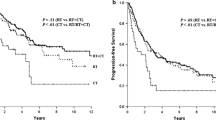Abstract
Background
Anaplastic oligoastrocytomas (AOA) are relatively uncommon high-grade gliomas. While oligodendroglial elements are thought to be associated with better outcomes, the magnitude of the difference is not clear.
Methods
Between 1980 and 1999, Mayo Clinic and the NCCTG conducted 10 trials of radiation therapy and chemotherapy in adults with newly-diagnosed high-grade gliomas. All pathology slides were reviewed by one of the authors (BWS or CG). We grouped patients by cell type and grade, compared survival distributions by the log-rank statistic, and performed multiple variable analyses.
Results
Of 1368 patients, 68 (5%) had AOA, including 21 Grade 3 (OA3) and 47 grade 4 (OA4), 153 (11%) had anaplastic astrocytoma (AA), and 1147 (84%) had glioblastoma multiforme (GBM). Patients with OA3 survived significantly longer than those with OA4 (P = 0.0001) or AA (P = 0.0044). Patients with OA4 lived significantly longer than those with GBM (P = 0.0005). The same differences were noted for PFS. Prognostic factors for survival identified by multiple variable analysis were histology, age, ECOG performance score, and extent of surgical resection, but not treatment administered.
Conclusions
Patients with anaplastic oligoastrocytoma have distinct outcomes based upon grade (OA3 vs. OA4) and in comparison with pure astrocytoma (AA or GBM). Future trials which include more than one histologic entity need to report results by cell type and grade and account for the varying prognoses in interpreting treatment outcomes.






Similar content being viewed by others
References
Donahue B, Scott CB, Nelson JS et al (1997) Influence of an oligodendroglial component on the survival of patients with anaplastic astrocytomas: a report of Radiation Therapy Oncology Group 83-02. Int J Rad Oncol Biol Phys 38:911–914
Shaw EG, Scheithauer BW, O’Fallon JR, Davis DH (1994) Mixed oligoastrocytomas: a survival and prognostic factor analyses. Neurosurg 34:577–582
Miller CR, Dunham CP, Scheithauer BW et al (2006) Significance of necrosis in grading of oligodendroglial neoplasms: a clinicopathologic and genetic study of newly diagnosed high-grade gliomas. J Clin Oncol 24:5419–5426
Glass J, Hochberg FH, Gruber ML, Louis DN, Smith D, Rattner B (1992) The treatment of oligodendrogliomas and mixed oligodendroglioma-astrocytomas with PCV chemotherapy. J Neurosurg 76:741–745
Kyritsis AP, Yung WK, Bruner J, Gleason MJ, Levin VA (1993) The treatment of anaplastic oligodendrogliomas and mixed gliomas. Neurosurg 32:365–370
Smith JS, Perry A, Borell TJ et al (2000) Alterations of chromosome arms 1p and 19q as predictors of survival in oligodendrogliomas, astrocytomas, and mixed oligoastrocytomas. J Clin Oncol 18:636–645
Reifenberger J, Reifenberger G, Liu L, James CD, Wechsler W, Collines VP (1994) Molecular genetic analysis of oligodendroglial tumors shows preferential allelic deletions on 19q and 1p. Am J Pathol 145:1175–1190
Bello MJ, Vaquero J, de Campos JM et al (1994) Molecular analysis of chromosome 1 abnormalities in human gliomas reveals frequent loss of 1p in oligodendroglial tumors. Int J Cancer 57:172–175
Maintz D, Fiedler K, Koopmann J et al (1997) Molecular genetic evidence for subtypes of oligoastrocytomas. J Neuropathol Exp Neurol 56:1098–1104
Bello MJ, Leone E, Nebreda P et al (1995) Allelic loss at 1p and 19q frequently occurs in association and may represent early oncogenic events in oligodendroglial tumors. Int J Cancer 64:207–210
Giannini C, Scheithauer BW, Weaver AL et al (2001) Oligodendrogliomas: reproducibility and prognostic value of histologic diagnosis and grading. J Neuropathol Exp Neurol 60:248–262
Kaplan EL, Meier P (1958) Nonparametric estimation from incomplete observations. J Am Stat Assoc 53:457–481
Mantel N (1996) Evaluation of survival data and two new rank order statistics arising in its consideration. Cancer Chemother Rep 50:163–170
LeBlanc M, Crowley J (1992) Relative risk trees for censored survival data. Biometrics 48:411–425
Cox DR (1972) Regression models and life tables. J R Stat Soc [B] 34:187–220
Efron B (1979) Bootstrap methods: another look at the jackknife. Ann Stat 7:1–26
Sauerbrei W, Schumacher M (1992) A bootstrap resampling procedure for model building: application to the Cox regression model. Stat Med 11:2093–2109
Walker MD, Alexander E Jr, Hunt WE et al (1978) Evaluation of BCNU and/or radiotherapy in the treatment of anaplastic gliomas. A cooperative clinical trial. J Neurosurg 49:333–343
Walker MD, Green SB, Byar DP et al (1980) Randomized comparisons of radiotherapy and nitrosoureas for the treatment of malignant glioma after surgery. N Engl J Med 303:1323–1329
Green SB, Byar DP, Walker MD et al (1983) Comparisons of carmustine, procarbazine, and high-dose methylprednisolone as additions to surgery and radiotherapy for the treatment of malignant glioma. Cancer Treat Rep 67:121–132
Curran WJ Jr, Scott CB, Horton J et al (1993) Recursive partitioning analysis of prognostic factors in three Radiation Therapy Oncology Group malignant glioma trials. J Natl Cancer Inst 85:704–710
Author information
Authors and Affiliations
Corresponding author
Rights and permissions
About this article
Cite this article
Buckner, J.C., O’Fallon, J.R., Dinapoli, R.P. et al. Prognosis in patients with anaplastic oligoastrocytoma is associated with histologic grade. J Neurooncol 84, 279–286 (2007). https://doi.org/10.1007/s11060-007-9370-y
Received:
Accepted:
Published:
Issue Date:
DOI: https://doi.org/10.1007/s11060-007-9370-y




